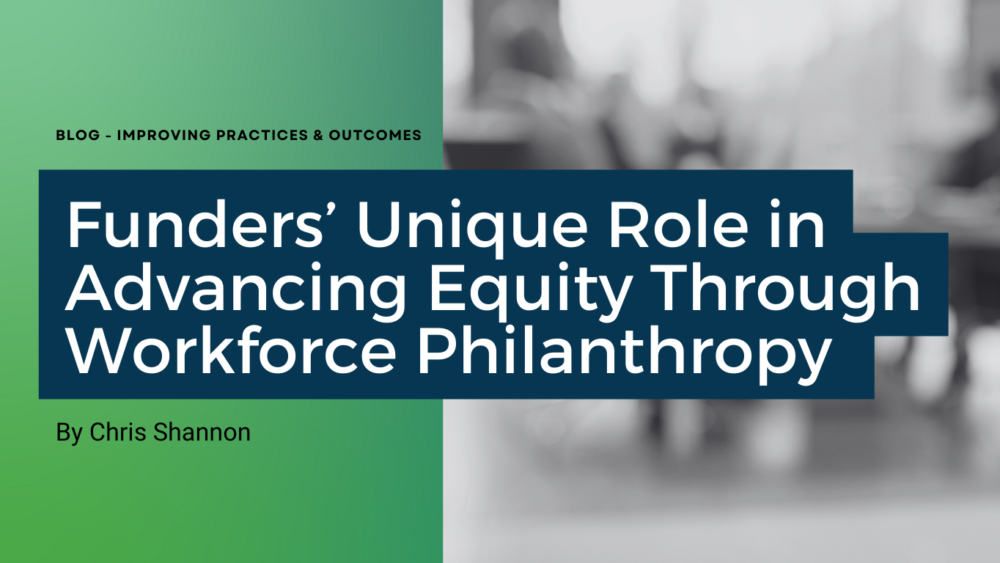When workforce development policy was linked to poverty in the 20th century, job training policies and programs became increasingly remedial in nature, reinforcing an American myth that poverty was a choice, the result of individual decisions. More recently. workforce policies have increasingly promoted a “work-first” approach (reframing program participants solely as “job seekers”) over skills building and pushing participants into the first job rather than working to match individuals with the right job.
Should the metrics define the system?
It is not surprising that the public workforce development sector metrics focus solely on moving clients into the labor market, thus framing how society sees the sector’s work. Among the six primary program performance indicators, three are employment-related and most directly connected to the labor market: employment, job retention, and median earnings within a certain time frame after program completion. The other indicators measure conditions that increase job placements—credential attainment, skills gains, and effectiveness in serving employers.
Although useful for understanding certain trends, these metrics cannot identify structural inequities or systems of oppression at play because they are transactional and centered on individuals rather than the system. In addition, these standard metrics obscure the workforce development system’s inability to influence economic mobility or address economic inequality. Recent research showed that not only were the median earnings of low-wage workers completing federally-funded job training about $10,000 less than the real median personal income of $33,706 for all workers, but these earnings convert to an hourly wage that is less than $15 per hour—a minimum yardstick used by advocates for improving living standards for low-wage workers. New metrics could better tell stories of systemic change that inspire new ways of programming, funding, evaluating, and theorizing.
Don’t get us wrong–wage is a critically important metric, but it is also an incomplete measure. It does not address other employment factors that contribute to economic mobility such as job security, access to benefits, workforce voice, and job quality. These additional factors are extremely important to workers and directly impact worker attraction, advancement, and retention, which in turn, impact employer productivity and a community’s economic growth. It is only when we measure what matters that we will be better positioned to address disparities and produce more lasting change in our communities.
How one philanthropic organization explored alternative metrics though a learning project
In 2022, the Greater Twin Cities United Way (GTCUW) created a learning project with Corporation for a Skilled Workforce (CSW) to explore alternatives to the traditional six workforce development metrics and the role these guiding metrics could play in influencing racial equity change in workforce development. GTCUW charged its 2022-2025 Economic Opportunity Employment & Training grantees with identifying a program metric that more closely aligns with that organization’s mission and to them, serves as a stronger signal of the organization’s desired impact.
Throughout this project, the GTCUW sought to better understand how non-profit organizations in the Twin Cities region support groups of people who have experienced marginalization and oppression, how organizations leverage—or could leverage—their power to negotiate and influence employers, education, funders, and government towards change, and how funders might harness that influence to move systems toward greater equity.
How grantees would define success
Metrics proposed by grantees measured conditions that promote successful job placement and retention—such as community involvement and a strong support network. They also assessed employer benefits and culture that better support populations in crisis, such as domestic abuse survivors, and career growth and advancement for underrepresented populations. One organization uses an existing workforce development metric, median earnings, as a proxy for household income for their Native community members and routinely compares it to other participant income data by race.
Grantees also discussed that “success” is often defined by a federal agency or the employer but not necessarily from the participant’s perspective. How would they define success? What might those metrics be if they were more culturally responsive? For example, paid time off for the loss of a loved one is usually defined as “immediate family;” some cultures might prefer taking time off to mourn the loss of a community member even if it means losing a job. and may take time off.
Traditional workforce development system metrics are not culturally responsive. Cultural beliefs might also influence how a program participant views career advancement or higher wages. Our existing metrics equate earning, and increasing one’s earnings, with program success, but that does not always reflect the perspective of the program participant.
Organizations’ success metrics align with participants’
These findings align with what we are learning from other projects. Program success tends to be based on hard data—graduation percentages, average salary after the program, etc.—that often speak to outputs, while participant definitions were centered around personal satisfaction, self-esteem, and respect in the workplace, which speak more to impact. For example, several CSW projects highlight how feeling safe—physically, culturally, and emotionally—is a critical component of training and job placement success.
Building confidence through increased professional self-esteem and increased community support networks not only resonates with workforce program participants, but also more closely aligns with the mission and goals the community-based organizations that serve them. Both organizations and those they serve agree that building confidence and a sense of belonging directly contribute to more lasting change in the lives of program participants. They are also more indicative of a network of factors that lead to sustained financial stability and mobility rather than starting wages or an earned credential.
A path forward
If the role of workforce development philanthropy is to address social needs and promote social justice and equity, then more learning conversations like these should be a priority for funders and their grantees. Developing a shared agenda through learning conversations that challenge traditional workforce metrics could move metrics beyond the transactional, to those of greater importance to organizations and program participants, resulting in increased longer-term impact and true societal change.

Meet the Author
Chris Shannon
Chris is a Senior Policy Associate with CSW’s Improving Practices and Outcomes Team. Chris supports systems change and transformation by developing organizational capacity through learning conversations, data analysis, and promoting shared insights to benefit systems. Continue Reading >>



Comments are closed.